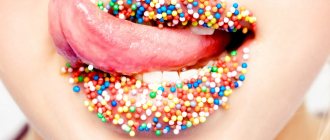As you know, sweets and starchy foods are the worst enemies of slimness. Read below to learn how to give up these foods forever and lose weight at home!
Poor nutrition is the first thing you have to face on your path to slimness. The presence of sweets and flour in the diet affects the figure in an extremely negative way. Therefore, avoiding these products is really necessary! At the same time, in addition to excess weight, skin problems will go away, digestion will improve, the functioning of the heart and blood vessels will normalize, and the risk of developing diabetes will decrease.
State the motive
Everyone must decide for themselves why they want to stop eating sweets and starchy foods. Someone dreams of fitting into their favorite dress or attracting the attention of the opposite sex. Some people prefer to monitor their health and prolong their youth. For some it is important to have healthy children. The goals can be anything. The main thing is that they are so important to you that you don’t leave the race halfway.
Formulate a motive in your head and constantly work on this topic, like a mantra: “I want to give up sweets and starchy foods as much as possible, because it is harmful to my figure, health, and activity.”
If this is not enough, then literature and the media work great, which are simply full of headlines about the dangers of obesity and the terrible consequences of excess weight. For some, reading a couple of lines will be enough to motivate themselves for the rest of their lives.
Counting calories is also a good help. Sometimes, after comparing the number of calories allowed by nutritionists to consume with those that a person actually absorbs per day, he once and for all gives up sweets and starchy foods.
Causes of food addiction
Overcoming cravings for sweets and flour is more difficult for some people, easier for others. Some people eat as much candy and sandwiches as they want and remain thin, while plump people, even following a strict diet, cannot lose weight. It all depends on the reasons that caused the addiction and the characteristics of the human body.
There is an opinion that the key to the success of any diet is willpower, and the main problem of overweight people is excessive eating. This is true, but only partly.
The fact is that the cause of an excessive addiction to sweets and starchy foods can be:
- metabolic disease;
- lack of chromium, magnesium, calcium and other important microelements that maintain blood glucose levels;
- hormonal disorders (eg, insulin resistance);
- hereditary predisposition to addiction to sweets;
- consequences of concussion, hypotension, osteochondrosis (due to insufficient blood supply to the brain there is not enough glucose).
A sign that a sweet tooth is based on health problems may be the fact that a piece of candy or a bun becomes a “pill” for a physical illness, for example, a headache.
A person begins to feel better after eating a sweet product due to the fact that the simple carbohydrates contained in it are very quickly broken down into glucose and delivered as an emergency energy boost to the body.
It becomes clear that to eliminate the physiological reasons for the love of sweets, willpower alone will not be enough; the help of a doctor will be required.
Psychological causes of sweet addiction include
:
- the habit formed in childhood of receiving sweets as encouragement and reward for work;
- the habit of “eating” negative emotions: sadness, anxiety, fear, self-doubt;
- the habit of “eating” stress, failures, troubles at work and at home, conflicts and just a bad mood;
- the “forbidden fruit” effect - what is forbidden is what you want most.
The mechanism of addiction to sweets and starchy foods is based on the habit of treating tasty food as a source of joy, happiness and pleasure, and not as food. Yes, indeed, sweetness can lift your spirits, give you optimism and self-confidence, due to the fact that it stimulates the production of happiness hormones, but this is a temporary and short-term measure.
A cake or bun will not solve the problem, the food will be eaten (and most likely in excess of the permissible norm), and the psychological problem will remain unresolved.
Nutritionists allow the consumption of simple carbohydrates, but in very small quantities, approximately 5% of the total carbohydrate intake. It is not forbidden to treat yourself to a spoonful of honey or a slice of dark dark chocolate once a day, the main thing is to know when to stop.
Wean yourself off gradually
If you have formed a motive and decided to give up sweets and starchy foods, remember: do not rush. Otherwise, there is a risk of falling into depression. Reduce your sugar and flour consumption gradually. For example, on the first day of your new life, instead of two spoons of sugar, put one and a half spoons of sugar in your coffee, instead of three sweets, eat two, instead of five cookies, eat four.
Each subsequent day, reduce the dose of harmful foods by one serving. By the end of the first week, the body will get used to it and stop demanding sweets.
Do the same with bread: instead of white, take rye, then bread with bran, and then eliminate it from the diet completely.
An approximate scheme for gradually giving up flour products, sugar and all kinds of sweets looks like this:
| First week | Avoid sugary sodas and juices (even freshly squeezed juice contains large amounts of sugar), and stop adding a few teaspoons of sugar to your tea and coffee. If you cannot tolerate unsweetened black tea, drink it with a dash of honey (not sweetener) or switch to herbal teas. It is acceptable to drink coffee with milk. |
| Second week | Get rid of your stocks of flour and sweets, stop baking or buying new sweets and reconsider your eating habits. Keep candy, chocolate and cookies out of sight. Remember that dried fruits are not at all a “safe” substitute for sweets and contain a large amount of sugar. |
| Third week | Learn to see the “hidden sugar”. Pay attention to the composition of the products (breakfast cereals, ketchup and other sauces contain sugar), and also study its synonyms. The fact is that food manufacturers often mislead consumers by labeling them “sugar-free,” but using substances related to sugar. Fructose, glucose syrup, glucose, maltodexin, dextrose, sucrose, agave syrup, honey are all sugars. |
Why does the body need sugar?
Both sweet and starchy foods are primarily carbohydrates, which are the main sources of energy in the human body. During light daily activity - walking, housecleaning, mental activity - carbohydrates are broken down and release energy, which we use for movement.
In addition, the physiological desire to gobble up something high-calorie and tasty can arise when you are tired or stressed. Simple carbohydrates, which are found in sweets, help quickly satisfy hunger, raise blood sugar levels, increase overall tone and, of course, improve mood. In addition, addiction to sweets may indicate that the body lacks certain hormones, such as endorphins or serotonin.
As follows from all of the above, it is impossible to completely exclude carbohydrates from the diet. But limiting their consumption, especially if you have problems with excess weight, is definitely necessary. Let's figure out how to do this correctly.
Replace unhealthy foods with healthy ones
In order to help yourself overcome sweet cravings, you need to replace them with protein. The fact is that eating protein will reduce your need for food. To prepare the drink, simply dissolve protein powder, which is sold in stores, in regular milk.
People often consume sweets to combat depression and lift their spirits, so to speak, to “eat stress.”
If your life is full of such situations, replace sweets with fruits or nuts, include honey in your diet, and enjoy diabetic desserts. However, remember that here you need to know when to stop. At the initial stages, you can simply replace harmful foods with healthier ones:
| Harmful products | Alternative |
| Milk chocolate | Dark chocolate (cocoa content 50-70%) |
| Cake | Marshmallow |
| Ice cream | Fruit ice |
| Sugar | Honey, stevia |
| Candies | Raisins, prunes, dried apricots, dates |
| Bakery | Crispbread with nut butter |
| Buttercream cakes | Cakes with yoghurt cream |
| Sweet mousses | Fruit jellies |
| Potato chips | Apple or pear chips |
| Taffy | Dried berries (strawberries, raspberries, blackberries, rose hips, strawberries, cherries) |
| Milkshakes | Water-based drinks (with lemon, grapefruit, tangerines, non-alcoholic mulled wine) |
How to overcome sweet cravings
Choose what you can do today and do it. Yes, most of you will need patience and persistence in completing some points. But among them there are also those that can be implemented quite quickly. Start with the easiest options for you, don’t force things.
- Balanced diet.
Your diet should have enough proteins and complex carbohydrates. Pay attention to legumes and whole grain cereals. It is also necessary to eat fresh fruits and vegetables every day; it is advisable to eat 300–500 g of vegetables and fruits combined per day.Try to avoid semi-finished and ready-made products, because they usually contain added sugar, as well as many other harmful synthetic ingredients. Minimize your consumption of processed food, try to buy whole foods more often and cook for yourself. It is also very important to eat enough. If you don’t do this, but regularly limit your body, then it won’t take long for you to indulge in something delicious. Don't overeat, but don't live from hand to mouth either.
- Drinking regime.
We are made up of approximately 80% water. For the body to function properly, it needs to constantly replenish its reserves. Try to drink enough (1.5–2.5 liters per day), but maintain intervals - drink two hours after eating and 30 minutes before it.In addition, in our brain the nerve centers that regulate feelings of hunger and thirst are located close to each other. This leads us to sometimes confuse hunger with thirst. Therefore, try to always drink a glass or two of water half an hour before meals.
- More fiber.
Fiber regulates blood sugar levels and cleanses the intestines very well of waste and toxins. The recommended daily intake of fiber is 40 to 50 g. If your diet is rich in fruits, vegetables, whole grains and legumes, then you may not need to add fiber. But if this is not the case, then try a separate supplement, such as bran or psyllium - the husk of psyllium seeds. - Probiotics.
Probiotics will help you restore the balance of intestinal microflora. They are rich in fermented foods such as sauerkraut, oriental kimchi and tempeh. Flax seeds, whole grains, apples and bananas also contain them, but not in such quantities as, for example, sauerkraut. - Mindful eating.
If you are distracted by your smartphone/book/movie or perhaps emotional conversations while eating, you are likely to eat more. In addition, there may be problems with the release of necessary food enzymes - after all, digestion begins in the mouth when, while chewing, we become aware of the taste of food, when we like it. - Replacing unhealthy sweets with healthy ones.
It will take time, but it will be worth it. Gradually, you can completely replace harmful foods with much healthier ones. For example, instead of sweets, try eating dates, raisins and other dried fruits. Roll homemade sweets from dates, coconut flakes and cocoa, make bars from rolled oats, dried fruits and dried berries.Sweet fruits—oranges, bananas, grapes—can also satisfy your sweet tooth. Fruit smoothies with the addition of flax/sesame/chia and honey will fit perfectly into our task. If you haven't tried homemade ice cream made from frozen bananas and berries, now is the time to do so.
- Audit of food supplies.
Harmful sweets are out of sight, healthy ones are out of sight. Make yourself a list of healthy sweets and stock up on them. It won’t work out right away, be patient and don’t scold yourself for failures. It is also important not to start bingeing on healthy treats. Especially dried fruits, nuts and all sorts of multi-ingredient dishes. Remember that the medicine for poison differs only in dosage. - Rule out nutritional deficiencies
Get tested and, if deficient, consult a qualified physician about supplement choices and possible causes of the deficiency (not always due to insufficient intake of nutrients from food). - Regular physical activity.
US scientists conducted a study which concluded that intense exercise reduces cravings for chocolate in people of normal weight7. In addition, regular exercise will help you cope with stress, improve your mood, prevent many diseases and prolong your life. Did you do morning practice/exercises today? - Adequate and healthy sleep.
If you don't get enough sleep, go to bed after 11 pm, spend time on your phone before bed, overeat at night, sleep with the lights on - fatigue, chronic stress and hormonal imbalances can become your constant companions. And this can even lead to cravings for sweets.Healthy sleep is incredibly important. Preparing for it a few hours in advance is equally important. Eliminate doping (coffee, alcohol, etc.), screens, restless activities.
- Walks in the open air.
Researchers at the University of Exeter (UK) found that just 15 minutes of walking can reduce chocolate cravings8. Walking is simply vital for our health. If you have the opportunity to walk in nature or in parks, be sure to use it. - Regular body detox.
Periodic fasting, gentle cleansing, fasting days and other fairly well-known detoxification methods will help you maintain your physical body in a more or less clean state. The fact is that toxins and wastes that we absorb with food, as well as waste products of our body, are retained in the body and are harmful to health and well-being. Cravings for sweets can be a symptom of slagging. - Divide into small pieces
One of the easiest recommendations on how to reduce cravings for sweets is to disassemble your treats into small parts. This helps trick our brain. Savor every little bite and you will feel full much sooner. - Learn to cope with stress without sweets.
Exercise, yoga, meditation, journaling, organizing your time can really work wonders. Add more mindfulness and activities into your life that lead you to health and inner peace. - Remember the art of small steps.
Don't jump ship to the ball, start gradually. For example, if you don't exercise, start by simply doing 5-10 minutes of daily exercise in bed. Anyone can do this. If you introduce many innovations at once and force yourself in the name of their implementation, then very soon you will abandon it. You will develop an underlying feeling and loss of self-confidence that will subsequently prevent you from trying to make positive changes in your life. - Be consistent and regular.
Regularity is the key to success. Even if you are very tired, or you have to miss your daily meditation session, find 5 minutes during the day or before bed and make sure to do it, even if it’s not perfect. Try to overcome perfectionism and laziness. Without regularity in such matters you cannot cook porridge. - Service.
Find ways to give selflessly to the world. This will help you increase your sense of satisfaction and self-satisfaction, the lack of which can cause addiction to goodies. But try to donate time/energy/things/money wisely - without expecting anything in return, from a state of love and awareness of the consequences for those to whom you donate. (link/video to explain what it means to sacrifice in the three gunas)
Give up rituals
Give up all rituals associated with eating sweets: for example, tea with colleagues, visiting a theater buffet, going to pastry shops and cafes, and so on. Don’t flatter yourself with the hope that you can refuse candy, for example, during your usual tea party at work. It is necessary to generally replace the consumption (or purchase) of sweets with something completely unrelated to them.
Also, stop rewarding yourself with sweets. This forms an unhealthy habit.
First you complete an important project and buy a cake, and then you start eating cakes when you are stressed because you associate sweets with success and joy.
It’s better to reward yourself with something inedible or put the money you were going to spend on sweets in a piggy bank.
How to give up sweets correctly?
Dr. Tharman also states that “if you want to achieve long-term results, then abruptly stopping sugar consumption is the only true solution to the problem, since even if you have even one candy, you will always want to eat another.” He warns that the first five days will be very difficult, perhaps even accompanied by insomnia and irritability. In the second week, all these symptoms will pass, and in the third you will no longer miss sweets.
You need to start by eliminating all sugary foods from your diet, including hidden sources containing sugar: low-fat salad dressings, fruit and vegetable sauces, yogurt with additives. On this ship, it is important to have all family members on board to prevent it from sinking. After all, if you like sweets, then most likely they will not refuse it either. According to the doctor, when the desire to eat something sweet overcomes you, chewing gum or just tea would be an excellent solution.
If there is a celebration coming up, such as a birthday, one option is to stay late at work and skip the cake cutting ceremony to avoid temptation. And instead of drinking sweet coffee with candy during a break, invite your colleagues to take a walk in the fresh air.
Drink water
Stop quenching your thirst with sugary carbonated drinks. Remember that one can of lemonade contains about 39 grams of sugar, which is more than half the daily requirement. Don't think that juices are much healthier than soda: a glass of orange juice, for example, contains about 33 grams of sugar.
There is no sugar or calories in water. Therefore, this is the best drink for maintaining water and electrolyte balance in the body.
Do not forget to drink enough ordinary water (daily intake: 1.5-2 liters, excluding other liquids).
And as soon as you feel the need for something sweet, take a few sips and eat a slice of apple. This will help overcome harmful cravings.
Chrome for sweet cravings
Chromium is a vital trace element. It is involved in lipid metabolism, and also helps the body's cells absorb glucose by increasing the permeability of their membranes, and enhances the functions of the hormone insulin.
Thus, with a chromium deficiency, the absorption of glucose may deteriorate, which means its deficiency may appear, which results in a strong craving for sweets. It is better not to guess which microelement is missing in the body, but to find out with the help of laboratory tests.
The daily intake of chromium for adults is from 50 to 200 mcg. If there is a deficiency of this nutrient, it is recommended to enrich your diet with whole grains, broccoli, green beans, and beets. Brewer's yeast is considered a source of chromium.
But, unfortunately, due to its very low absorption (absorption) in the gastrointestinal tract - up to 5% of the total amount - replenishing the deficiency of chromium with products is unlikely. Therefore, chromium supplements in the form of picolinate will be relevant here. Since excess chromium is toxic to the body, it is strictly not recommended to use this supplement without laboratory testing; be sure to consult a specialist!
Of course, it’s great if for you the answer to the question: “How to reduce cravings for sweets?” will be a basic replenishment of nutritional deficiencies. But while you are figuring out your chromium level, we recommend that you start taking action in other available directions.
Adjust your diet
Cravings for sweets and starchy foods are sometimes inextricably linked with poor diet. So try to stick to proper schedule and rules.
Ideally, meals should be fractional and balanced at the rate of: a small portion every 3 hours.
It is precisely too long breaks between breakfast and dinner that traditionally encourage overeating and abuse of flour products. Your ideal eating schedule should be like this:
- 7-8 a.m. – breakfast,
- 11 a.m. - snack
- 13:00 – lunch,
- 15 o'clock in the afternoon - snack,
- 18 pm - dinner.
Eat even the healthiest sweets before 3 p.m., or even better, for breakfast. This will make it much easier for you to refuse temptation during the day. In addition, in the morning you will be charged with energy and will be happy to spend it, and all carbohydrates after 15.00 will certainly transform into excess weight. In general, choose only healthy foods for the menu with sufficient amounts of proteins, fats and slow carbohydrates.
Details
If you have a sweet tooth, it's completely natural. Preferring sweetness to any other taste helped our distant ancestors survive. Bitterness in nature indicates poison, sweetness indicates nutrition. Finding food is not a trivial task, and death from starvation is common. Under such conditions, those who are good at recognizing bitterness and sweetness and are highly motivated to avoid the former and find the latter live longer and have a greater chance of passing on their genes to subsequent generations. Including those responsible for cravings for sweets.
In the body, sugar increases the level of the neurotransmitter dopamine - the so-called “happiness hormone”. To be more precise, it does not give happiness, but motivates us to get something to satisfy our needs. In the case of sweets, this something is energy, extremely valuable for the inhabitants of the Paleolithic era. Back then, most of the foods that the ancestors of modern people ate were no sweeter than carrots. Honey is one of the few exceptions.
Then people took up farming and began to eat more starchy foods. But everything changed radically when we learned to extract pure sugar from these products and add it everywhere. And now the problem is the opposite of what faced hunter-gatherers: it is difficult to find food without sugar. It is found not only in candies, cookies and cakes - obviously “sugar” products, but also in sauces, bread, semi-finished products and ready-made dishes.
What's wrong with cravings for sweets?
Even before the Paleolithic, about 15 million years ago, during one of the periods of global cooling, mutations occurred in the genes of our ape-like ancestors, which allowed the body to more efficiently store reserves for a rainy day, easily turning sugar into fat. Today is not a rainy day, there is an excess of sweets, fat reserves are growing, and this, in turn, can lead to a deterioration in metabolic health.
Another danger is that sugar, or more precisely glucose, is an extremely active molecule that can react with proteins and change their structure. The concentration of glucose in the blood is regulated by the hormone insulin: after eating, it is released by the pancreas, and insulin allows cells to use glucose to produce energy. But if the insulin system malfunctions (the first signs of diabetes) or if glucose peaks occur too often (you eat carbohydrates and sweets many times a day), then excess glucose in the blood will gradually destroy, among other things, the walls of blood vessels, which will lead to the development of atherosclerosis and cardiovascular diseases.
Glucose promotes inflammation in the body, which in turn leads to fatigue, anxiety and depression.
Doctors and health organizations recommend that adults and children reduce their intake of added sugar, which is found in almost everything from sugary drinks to sauces, breads, breakfast cereals and yogurts. WHO, for example, calls for reducing sugar to 5% of total calories consumed - that's about 25 g or 6 teaspoons of sugar per day. For comparison: a 0.33 liter can of Coca-Cola contains 35 g of sugar; 100 g of “healthy” breakfast cereal may contain 20-30 g of sugar.
How to stop eating so much sugar?
The problem has two sides: how to plan a diet with minimal sugar content (technical) and how to stop craving sweets (psychological). First, about the simpler side, the technical one.
The best way to eat less sugar is to learn to identify it in food and not keep such food in the house. Chocolate, baked goods and Coca-Cola are definitely “sugar” foods. Bread, sausages, ready-made salad dressing, low-fat yogurt, and cereals that say “sugar-free” on the label are less obvious candidates, but processed foods almost always contain sugar, and sometimes in significant quantities. Sugar can be hidden under different names: corn syrup, maltose, fructose and several dozen other options.
There are also plenty of tricks you can use to push sugar out of your diet: replace cookies with carrots or dark chocolate, eat bitter arugula, play Tetris or take a walk when you want candy, and so on. But they don’t work well if the reason for your craving for desserts is not a love of sweet taste, but so-called emotional hunger.
“Emotional hunger” is a fairly common concept: this is what some psychologists and nutritionists call the desire to eat something high in calories, contrasting this impulse with real, physiological hunger.
Real hunger
it grows gradually, is felt below the neck, appears a few hours after eating and goes away after eating. The meal itself is satisfying.
Emotional hunger
comes suddenly, is felt above the neck, does not depend on time and is felt even after eating. At the same time, eating food causes feelings of shame and guilt.
Watch yourself. If your relationship with sweets sounds like the description of emotional hunger, try to minimize sweets in your diet by analyzing and changing your habits or dealing with the “problematic” feelings themselves.
How to change the habit of eating sweets?
We associate eating with certain emotions and situations, so sugar cravings can be viewed as a learned behavior—and addressed through behavioral science.
Step 1: Identify triggers.
Habit is a reaction to a stimulus. What happens before you order carrot cake with your coffee or open the refrigerator in search of ice cream? Try to track the sequence of events several times and write them down at least in the notes on your phone. The trigger can be different situations and emotions - not just those that you clearly identify as “negative”.
Step 2: Have a plan in place.
If the triggers are clear, you need a plan—alternative behaviors when the habit takes over again. This advice was given to the doctor of medicine and author of the book “One More Piece!” David Kessler Behavioral Experts. The point is that it is easier to resist habits when you have developed a plan in advance: specific actions that you will take when something happens that you are used to eating sweets (trigger). The more often this plan is implemented, the sooner you will develop new automatic behavior that will allow you to cope with the old one. Solutions? Any other actions that can give you a feeling of self-care: drink a mug of hot tea, chat with loved ones, pet the cat, do a breathing exercise.
Step 3. Argue with your thoughts.
Behavior is largely controlled verbally, through mental pronunciation. Eating problems are no exception. This is the way to overcome the automaticity of habit. Psychotherapist Karin Melvin suggests using the ABC model: highlight the trigger (Activating experience), irrational beliefs that push you to eat sweets (Beliefs), and consequences (Consequences). Separately, imagine or even write down arguments that would challenge your beliefs. For example, the belief that the only way to calm down is to eat chocolate can be countered by many others: “Chocolate actually has nothing to do with my situation”; “Perhaps the desire itself is caused only by bright advertising of chocolate”; “The brain acts automatically - why should I follow this decision?”; “Walking is a healthier way to relieve stress,” and so on.
Meditation can help deal with automatic desires and emotions - there are studies showing that such practice allows you to better understand what causes the need for sweets, and consciously make the choice “to eat or not to eat.”
How to deal with emotions?
It is believed that behind emotional hunger there is a strategy of emotional avoidance: candy allows you to distract yourself and not have to deal with difficult experiences. The solution is to stop running away from them. It's a difficult process, but accepting your emotions will increase your ability to tolerate the discomfort that causes sugar overeating. That’s why it helps more effectively than just behavioral methods.
Step 1. Name the emotion.
What feelings does eating sweets mask? To recognize them, the visualization technique of non-diet nutritionist Carol Grannick comes in handy. Sit in a quiet place, close your eyes and remember the moment you ate a chocolate bar. Imagine that you only ate two slices and stopped. Ask yourself: what thoughts and feelings does this evoke? Once you find the definition you want, write it down. This will reduce the intensity of the emotion.
Step 2. Take a break.
When the desire to eat your emotions with a piece of cake arises, nutritionist Svetlana Bronnikova advises asking yourself: can you put it off until later? If you can wait 15 minutes and do something else, do it. And then ask yourself: do you want a cake? Or has the desire changed? If everything is the same, eat the cake and don't beat yourself up about it. The goal is not to give up food, but to learn to tolerate anxiety.
Step 3: Focus on problematic feelings.
A paradoxical method from the arsenal of dialectical behavior therapy. The point is not to try to control emotions, but to ride them like a wave (that’s why the technique is called “surfing”). This is what it looks like. You close your eyes and focus on the experience that makes you want sweets. There is no need to try to change it somehow. Just observe what sensations it causes in your body. So you will notice that the intensity of the experience is not constant: feelings sometimes reach peaks of pain, then decrease to the level of calm. Glide on them like surfers glide through the water. The peak, most painful moments will become shorter, and the experiences will become such that you can cope without chocolate.
Also on topic.
How I gave up sugar and found out the psychological reasons for my addiction. The story of psychotherapist Ev Khazina. Link.
Have fun and exercise
Do something interesting to take your mind off thoughts about sweets and starchy foods. It doesn’t matter what you do (walk down the street, watch a movie, visit the theater, read a book, knit, sew), the main thing is that it brings you pleasure, which will take all your attention. In order to suppress thoughts of sweets, you can engage in physical activity or breathing exercises, after which the craving for heavy food disappears.
What techniques do you use to limit your intake of sweets and starchy foods?











